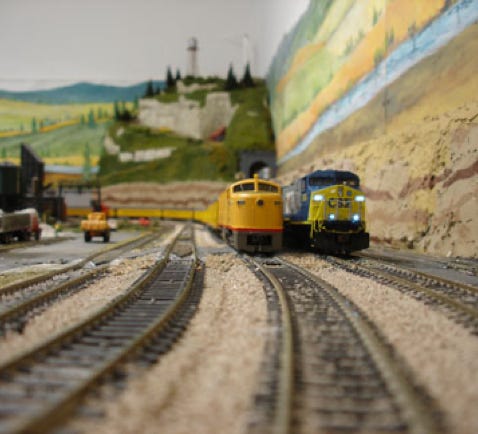12 years of fun filled memories and comaradery
A slide show of our layout and several of our members at play. The show will start automatically. To stop aslide should you wish to examine it closer, place the mouse pointer over the slide.
The slide show shows a portion of the Kings Point Model Railroad along with a few of my buddies that provided entertainment for hundreds of visitors. For more than 35 years, the railroad advanced from an analog system (DC or Direct Current) to a Digital Control System which mimicked a fully operational railroad.
On DC railways —meaning Direct Current — power for the engine was applied to the track and all trains on the track got the same power. The electrical supply went to the track and all engines worked in the same way. That is, all trains on the same track went in the same direction and started and stopped at the same time.
Thus, by changing the power level. all the trains slowed down or sped up. There was no independence between trains unless you had different sections of track with their own DC supply. While this type of operation gave us hours of entertainment, the real fun was just around the corner with DCC.
On DCC railways, each train was controlled independently. You could have one train reversing, another going forward at full speed and another slowing down all within the same section of track (sounds like an accident waiting to happen).
Additionally, DCC trains could have extra electronics in them enabling special effects such as lighting, sound and even fake steam and smoke – and all controlled independently, thus mimicking a real railroad operation.
Our model railroad was a 360 degree layout and typically ran as many as eight trains at once, limited only by space since the system could handle much more. Typically one or two passenger trains and 5 or 6 freight trains were making the layout journey at one time. Each member or visitor operating a train had a hand command module that would allow them to adjust speed, direction, sound if installed, and lights of the train they were operating. The “engineer” age limits were from two to 102 if they were able to hold the command module. It was extremely entertaining to watch those “engineers” who were serious about their operation and those who were having one of the better times of their life. I for one, enjoyed just being a kid again.
As a club member and train engineer, I was fortunate enough to have had one of the better times of my life .





























